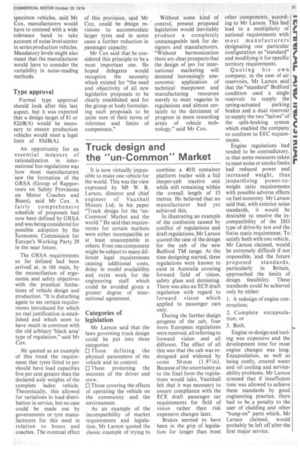Categories of legislation
Page 33

If you've noticed an error in this article please click here to report it so we can fix it.
Mr Larson said that the laws governing truck design could be put into three categories: O Those defining the physical parameters of the vehicle and its control.
O Those protecting the interests of the driver and crew.
Those covering the effects of operating the vehicle on the community and the environment.
As an example of the incompatibility of market requirements and legislation. Mr Larson quoted the classic example of trying to combine a 40ft container platform trailer with a full sleeper-cab tractive unit while still remaining within the overall length of 15 metres. He believed that no manufacturer had yet achieved this.
In illustrating an example of the confusion caused by conflict of regulations and draft regulations, Mr Larson quoted the case of the design for the cab of the new Bedford TM range. At the time designing started, three regulations were known to exist in Australia covering forward field of vision, safety glass and demisting. There was also an ECE draft regulation with regard to forward vision which applied to passenger cars only.
During the further design progress of the cab, four more European regulations were received, all referring to forward vision and all different. The effect of all this was that the cab was redesigned and widened by some 50 mm (1.97 in). Because of the uncertainty as to the final form the regulations would take. Vauxhall felt that it was necessary to ensure compliance with the ECE draft passenger car requirements for field of vision rather than risk expensive changes later.
Brakes seemed to have been in the grip of legislation for longer than most other components, according to Mr Larson. This had lead to a multiplicity of national requirements with most manufacturers designating one particular configuration as "standard" and modifying it for specific territory requirements.
Quoting his own company, in the case of air reservoirs, Mr Larson said that the "standard" Bedford condition used a single reservoir to supply the spring-actuated parking brakes and a dual reservoir to supply the two "halves" of the split-braking system which enabled the company to conform to EEC requirements.
Engine regulations had tended to be contradictory, in that some measures taken to meet noise or smoke limits had reduced power and increased weight, thus jeopardizing power-toweight ratio requirements with possible adverse effects on fuel economy. Mr Larson said that, with exterior noise standards, it would be desirable to resolve the incompatibility of the ISO type of drive-by test and the Swiss static requirement. To satisfy both with one vehicle, Mr Larson claimed, would be extremely difficult if not impossible, and the future proposed standards, particularly in Britain, approached the limits of design feasibility. These standards could be achieved only by either: I. A redesign of engine construction; 2. Complete encapsulation; or 3. Both.
Engine re-design and tooling was expensive and the development time for most engine changes was long. Encapsulation, as well as being costly, created water and oil cooling and serviceability problems. Mr Larson stressed that if insufficient time was allowed to achieve these standards by good engineering practice, there had to be a penalty to the user of cladding and other "hung-on" parts which, Mr Larson claimed, would probably be left off after the first major service.












































































































































